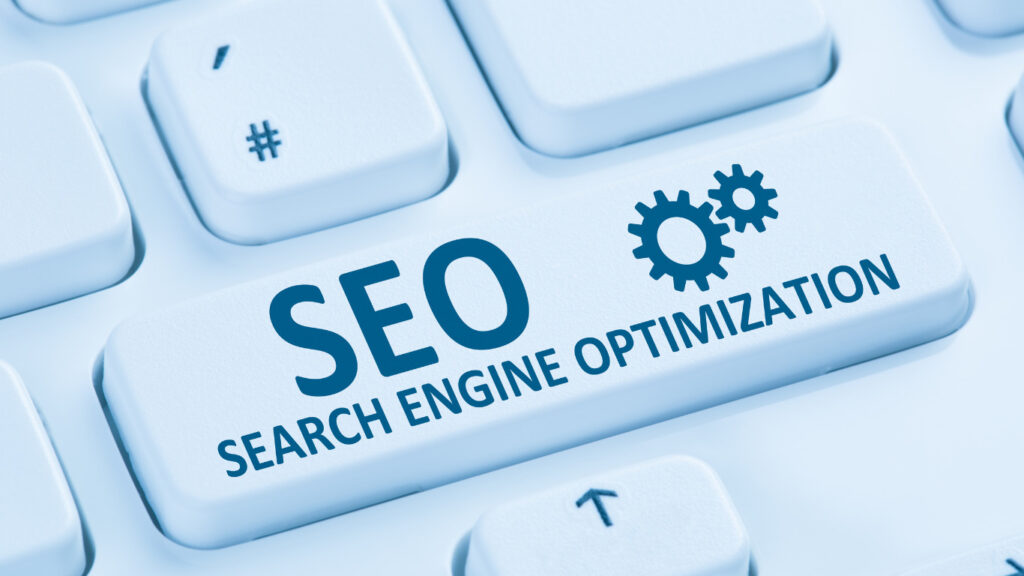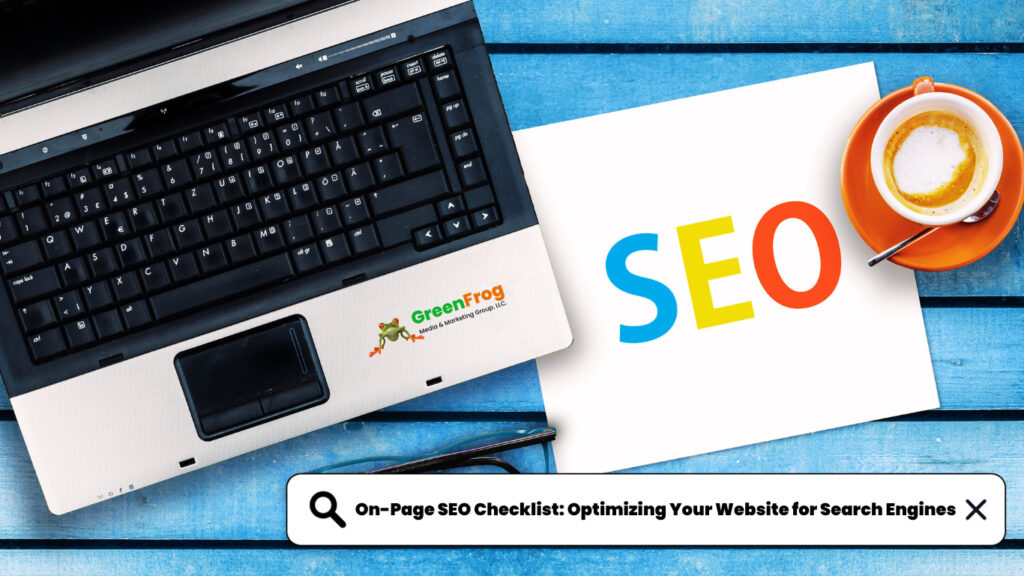I. Introduction
Having a well-designed website isn’t enough. To truly stand out, one must delve into the realm of Search Engine Optimization (SEO), and at the heart of SEO lies the critical concept of on-page optimization.
On-page SEO is the art and science of optimizing individual web pages to rank higher and earn more relevant traffic from search engines. It’s the foundation upon which your digital presence is built, ensuring your website is not just visually appealing but also easily discoverable by search engines and users alike.
The Significance of On-Page SEO

On-page SEO is the cornerstone of any successful digital marketing strategy. It’s the process of fine-tuning various elements on your website to align with the algorithms used by search engines like Google. By doing so, your site becomes more accessible, understandable, and attractive to both search engines and visitors.
When your website ranks higher on search engine results pages (SERPs), it not only gains visibility but also credibility and trust among users. That’s why understanding and implementing an effective on-page SEO strategy is essential for any website owner or digital marketer.
II. Keyword Research and Selection

Understanding the Significance of Keyword Research in On-Page SEO
Imagine keywords as the compass guiding search engines and users to your digital doorstep. Keyword research, the foundation of any SEO strategy, involves identifying the terms and phrases users are likely to search for. These keywords act as beacons, illuminating the path to your website amidst the vast internet expanse.
Guiding with Keyword Research Tools
Several tools, such as Google Keyword Planner, SEMrush, and Moz Keyword Explorer, empower website owners with insights into search volumes, competition, and related keywords. These tools transform the complex realm of user behavior into actionable data, allowing you to discern which keywords are worth targeting.
Tips for Selecting Long-Tail Keywords and Considering User Intent
Long-tail keywords, those specific, multi-word phrases, might wield less search volume, but they often boast higher conversion rates. By catering to niche user queries, long-tail keywords attract an audience genuinely interested in what you offer. Consider the user intent—are they seeking information, looking to make a purchase, or comparing options? Align your keywords with these intents for optimal results.
Strategic keyword selection involves a delicate balance. Opt for keywords that reflect your content accurately and resonate with your target audience. Think like your users. What phrases would they type into a search engine when looking for products, services, or information related to your website?
By investing time in comprehensive keyword research and understanding user intent, you lay a robust foundation for your on-page SEO endeavors. These insights not only enhance your website’s visibility but also ensure that the traffic drawn is genuinely interested in what you offer. Armed with the right keywords, you’re prepared to delve into the next stages of our on-page SEO journey, optimizing your website effectively and steering it towards digital prominence. Stay tuned for the upcoming sections, where we’ll explore the intricacies of title tag optimization, meta descriptions, header tags, URL structures, image optimization, content optimization, internal linking, and mobile friendliness, all integral components of a well-rounded on-page SEO strategy.
III. Title Tag Optimization
Title tags are the HTML elements that define the title of a web page. They appear as the clickable headline in search engine results pages (SERPs) and are displayed on the browser tab when the page is open. Search engines use title tags to understand the topic of the page, making them a critical factor in determining the page’s relevance to user search queries. Well-optimized title tags not only improve search engine rankings but also entice users to click through to your website, enhancing both visibility and click-through rates.
Guidelines for Creating Effective Title Tags
- Descriptive and Concise: Craft titles that accurately describe the content of the page while being concise and to the point. Long titles may get truncated in search results, so it’s essential to convey the essence of the page within 50–60 characters.
- Keyword-Rich: Incorporate relevant keywords naturally into the title. Research and identify primary keywords related to your content and integrate them seamlessly into the tag. However, avoid keyword stuffing, as it can lead to penalties from search engines.
- Unique Titles for Each Page: Every page on your website is unique, and so should be its title tag. Avoid using generic titles across multiple pages, as this does not provide specific information about the individual content of each page.
Tips for Optimization Across Different Pages
- Homepage: The title tag of your homepage should encapsulate the core theme of your website or business. Include the main keyword or phrase that represents your services or products succinctly.
- Product/Service Pages: For specific product or service pages, focus on including the product or service name along with unique selling points. Highlight what sets your offerings apart from competitors.
- Blog Posts: Titles for blog posts should be engaging and compelling. Use intriguing language to pique the reader’s curiosity while incorporating the primary keyword naturally.
- Contact and About Pages: Clearly indicate the purpose of these pages in the title. For the Contact page, include your business name and location. For the About page, focus on your brand name and a brief descriptor of your business.
IV. Meta Description Optimization

Meta descriptions are brief snippets of text displayed below the website link in search engine results pages (SERPs). They serve as concise summaries of the webpage’s content, offering users a sneak peek into what they can expect if they click the link. While meta descriptions don’t directly impact search rankings, they profoundly influence CTRs. A well-crafted meta description can significantly enhance the likelihood of users clicking through to your website.
Guidelines for Writing Compelling Meta Descriptions
- Be Concise and Descriptive: Keep your meta descriptions concise, ideally within 150–160 characters, to ensure they are fully displayed in search results. Describe the content succinctly, highlighting its unique value proposition.
- Create a Call-to-Action: Encourage users to take action by incorporating compelling calls-to-action (CTAs). Phrases like “Learn More,” “Discover,” or “Get Started” can evoke curiosity and prompt clicks.
- Highlight Unique Selling Points: Identify and emphasize the unique aspects of your content, products, or services. What sets your page apart from competitors? Highlight these distinctive features to capture user interest.
Tips on Including Keywords Naturally
While meta descriptions are not a direct ranking factor, incorporating relevant keywords can naturally reinforce the page’s relevance and attract users searching for specific terms. Here’s how to seamlessly integrate keywords into meta descriptions:
- Use Targeted Keywords: Identify primary keywords relevant to your content and include them naturally in the meta description. Avoid keyword stuffing, which can harm user experience and SEO efforts.
- Create Engaging Copy: Craft engaging and informative sentences that incorporate keywords organically. Ensure that the meta description reads naturally and provides useful information to users.
- Maintain Relevance: Align the meta description with the content of the respective page. Irrelevant or misleading meta descriptions can lead to high bounce rates and diminish the trust of visitors.
V. Header Tags (H1, H2, H3, etc.)
Header tags are HTML elements used to define headings and subheadings within your content. They not only establish a hierarchical structure, making your content more readable, but also provide context to search engines about the content’s organization. H1 is typically reserved for the main title, while H2, H3, and subsequent tags indicate subsections. Think of it as an outline for your readers and search engines, guiding them through your content logically.
Guide on Using Header Tags to Organize Content
Proper organization of content through header tags significantly improves the user experience. When visitors land on your page, clear headings help them understand the content’s flow. Not only do human readers value this readability factor, but search engine algorithms also do. Organizing content in a hierarchical manner allows both users and search engines to comprehend the main topics and subtopics, creating a seamless reading experience.
Tips on Incorporating Target Keywords in Header Tags
Strategic placement of keywords within header tags can significantly impact your website’s SEO. When search engines crawl your site, they pay close attention to these tags to understand the context and relevance of your content. Incorporate your target keywords naturally into the headers, ensuring they align with the respective section’s topic. However, it’s crucial to maintain a balance; keyword stuffing should be avoided at all costs. Focus on creating meaningful, informative headers that accurately represent the content beneath them. This approach not only enhances your SEO but also ensures that your content remains engaging and valuable to your readers.
VI. URL Structure

SEO-friendly URLs are pivotal in enhancing a website’s visibility. They not only make it easier for search engines to understand the content but also enhance the user experience. SEO-friendly URLs are typically short, descriptive, and include relevant keywords. For instance, instead of a convoluted URL like “www.example.com/pageID=123,” an SEO-friendly version would be “www.example.com/seo-friendly-url.” Such URLs are not only simpler to read, but users are also more likely to click on them.
Guide on Creating Clean, Descriptive, and Readable URLs
When crafting URLs, simplicity is key. Start with the domain name, then include a forward slash (/) and a succinct summary of the page’s content. For instance, a page about digital marketing services could have a URL like “www.example.com/digital-marketing-services.” This format clearly communicates the page’s topic to both users and search engines.
Tips on Avoiding Special Characters and Unnecessary Parameters in URLs
Special characters and unnecessary parameters can confuse search engines and users alike. It’s crucial to avoid symbols like &, %, or ?, as they can create complications in URL interpretation. Additionally, long strings of parameters (e.g., www.example.com/page?category=123&sub=456) should be avoided. Instead, opt for a structure that simplifies the URL, making it more intuitive and user-friendly.
VII. Image Optimization
Optimizing images serves a dual purpose: it enhances the user experience by ensuring fast-loading, visually appealing content, and it boosts SEO by making your website more accessible to search engine crawlers. Large, unoptimized images can slow down your website, leading to higher bounce rates and diminished user satisfaction. By optimizing your images, you provide a seamless browsing experience for your visitors while signaling to search engines that your site is well-maintained and user-friendly.
Guide on Using Descriptive File Names and ALT Tags for Images
When it comes to SEO, search engines can’t “see” images; they rely on descriptive file names and ALT tags to understand the content. Choose file names that describe the image concisely, incorporating relevant keywords where applicable. ALT tags, or alternative text, provide a textual description of the image. Not only do these practices enhance accessibility for users with disabilities, but they also offer valuable SEO opportunities. Descriptive ALT tags improve your website’s context for search engines, potentially boosting your visibility in image search results.
Tips on Reducing Image File Sizes
Large image files can significantly slow down your website. Users expect web pages to load quickly, and search engines consider loading speed as a ranking factor. To optimize images effectively, consider compression techniques. There are various online tools and plugins that can compress images without compromising their quality. Strike a balance between file size and image clarity to ensure your visuals retain their appeal while contributing to a seamless browsing experience.
VIII. Content Optimization
Content optimization is more than just sprinkling keywords; it’s about aligning your message with the needs of your audience. By optimizing your content, you ensure it’s not only relevant to your niche but also easily understandable and valuable for your readers. Search engines, especially Google, prioritize content that provides genuine value to users. Therefore, crafting content that informs, educates, or entertains is essential.
Guide on Creating High-Quality Content
Creating high-quality content begins with understanding your audience and their pain points. Research your target demographic thoroughly and identify the topics and questions they are interested in. Your content should be well-researched, accurate, and presented in an engaging manner. Use a clear and logical structure, breaking down complex ideas into digestible sections. High-quality content is not just about what you say but also how you say it; maintain a professional tone while injecting your unique voice to make your content relatable.
Tips on Using Variations of Target Keywords
While keywords are essential, their usage should feel natural within your content. Google’s algorithms have evolved to favor natural language and user intent over keyword stuffing. Instead of repeating the exact keyword, focus on using variations and synonyms naturally. This not only satisfies search engine algorithms but also enhances the readability of your content. Strategic placement of keywords in the title, headings, and throughout the content helps search engines understand the context of your page, making it more likely to rank higher in relevant searches.
IX. Internal Linking
Internal linking serves as the backbone of seamless user navigation and enhanced SEO. When users find relevant content easily, it reduces bounce rates and increases their time spent on your website. From an SEO perspective, search engines crawl through websites using links, making internal linking a powerful tool to guide search engine bots to important pages. This process ensures that valuable content gets indexed and ranked effectively.
Guide on Strategically Placing Internal Links
Strategic placement of internal links involves understanding your content’s flow and hierarchy. Start by identifying cornerstone content—essential articles or pages representing your website’s core themes. From these, create pathways to related posts or sections. For instance, if you’re reading about on-page SEO, a strategically placed link could guide you to a detailed article on keyword research. This logical linking enhances the user experience by offering them a natural progression through your content.
Tips on Using Descriptive Anchor Texts
The text you use for your internal links, known as anchor text, holds significant SEO value. Instead of generic phrases like “click here,” use descriptive text that clearly indicates the linked content’s topic. For example, if you’re linking to a guide on meta descriptions, your anchor text could be “Mastering Meta Descriptions for SEO Success.” Descriptive anchor texts not only provide context to users but also help search engines understand the linked page’s content, contributing to improved ranking opportunities.
X. Mobile Friendliness

In the age of smartphones, ensuring your website is mobile-friendly is no longer an option; it’s a necessity. Mobile-friendliness is not just about catering to mobile users; it significantly impacts your SEO efforts.
Mobile-friendly websites are not only favored by users but also highly regarded by search engines. Google, the leading search engine, gives preference to mobile-friendly websites in its ranking algorithm. This preference is due to the growing number of mobile users globally. Websites that are optimized for mobile devices provide a better user experience, leading to higher engagement, longer visit durations, and decreased bounce rates, all of which are positive signals for search engines.
Guide on Responsive Design and Mobile Optimization Techniques
Responsive web design is a fundamental approach to mobile optimization. It involves creating a website that automatically adjusts its layout, images, and content to fit various screen sizes, ensuring a seamless user experience across desktops, tablets, and smartphones. Implementing responsive design requires coding techniques such as CSS media queries and flexible grid layouts. Additionally, optimizing images and scripts to reduce load times on mobile devices is vital.
Mobile optimization also involves condensing menus and buttons for easier touch navigation, optimizing forms for mobile input, and ensuring that all interactive elements are easily accessible and functional on smaller screens.
Tips on Ensuring Seamless User Experience Across Various Devices
- Prioritize Speed: Mobile users are often on the go and have limited patience for slow-loading websites. Optimize your website’s loading speed by compressing images, leveraging browser caching, and minimizing HTTP requests.
- Intuitive Navigation: Simplify your website’s navigation for mobile users. Implement clear, easy-to-use menus and intuitive touch gestures to enhance user experience.
- Readable Content: Ensure your content is legible on smaller screens. Use a legible font size, maintain sufficient contrast between text and background, and avoid lengthy paragraphs.
- Optimize Forms: If your website includes forms, optimize them for mobile users. Use minimal form fields, provide clear instructions, and utilize input masks to simplify data entry.
- Interactive Elements: Test all interactive elements, such as buttons and links, to ensure they are easily tappable and function correctly on touchscreens.
XI. Conclusion
Incorporating these On-Page SEO strategies into your website’s design and content can significantly impact your online presence. By taking a holistic approach to On-Page SEO, you not only enhance your search engine rankings but also provide visitors with a seamless and enjoyable browsing experience. As you implement this checklist, remember that patience is key in the world of SEO. Regularly monitor your website’s performance, analyze the results, and make necessary adjustments to stay ahead in the competitive online arena. So, what are you waiting for? Start optimizing your website today and watch your online visibility soar, attracting more visitors and potential customers to your digital doorstep.




